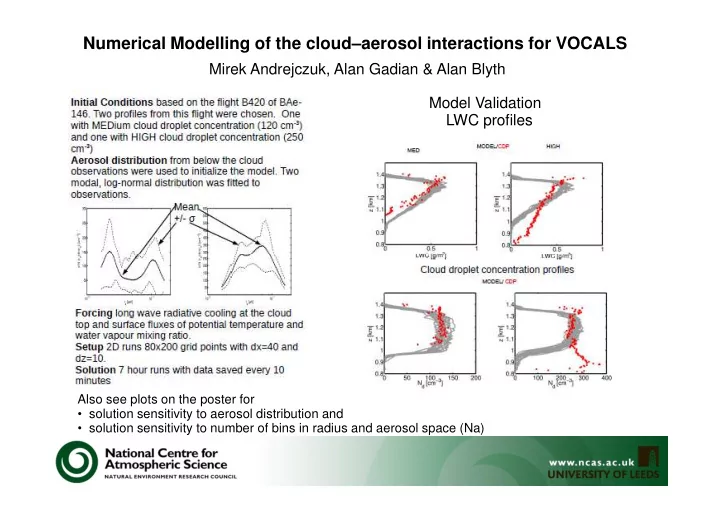

Numerical Modelling of the cloud–aerosol interactions for VOCALS Mirek Andrejczuk, Alan Gadian & Alan Blyth Model Validation LWC profiles Also see plots on the poster for • solution sensitivity to aerosol distribution and • solution sensitivity to number of bins in radius and aerosol space (Na)
Numerical Modelling of the cloud – aerosol interactions for VOCALS Conclusions ( some of ) : • Lagrangian representation of the microphysics can predict the observed LWC and cloud droplet concentration. • CDN and Qc are more sensitive to the uncertainty in the initial conditions (aerosol distribution) than to the number of bins in the Eulerian collision grid. • Cloud droplet spectrum depends on the number of bins used in the collision grid. See: Andrejczuk et al (2008) JGR 2007JH009445 : Andrejczuk et al (2010) JGR 2010JD014248 : plus 2 in preparation
Numerical modelling of stratocumulus over the South-East Pacific with WRF Mirek Andrejczuk, Alan Gadian & Ralph Burton WRF was used, initialised with GFS analyses, 00:00Z 12 Nov., and compare with B420, Nov. 13 2008. Sensitivity studies with: (a) 36,81,121 levels: (b) Resolution of 9km, outer and 3km inner: (c) Microphysics (Kessler, Thompson, Morrison) . (d) Land surface and boundary layer: (R) Plein-Xiu/Noah/ACM2: (SF1) Monin-Obukov / thermal diffusion / YSU: (SF2) Monin-Obukov (ETA) / thermal diffusion / MYJ TKE. Look at the poster to see model profiles compared with observations.
Numerical modelling of stratocumulus over the South-East Pacific with WRF Also vertical velocity plots shown in the poster
Numerical modelling of stratocumulus over the South-East Pacific with WRF Holes Formation Conclusions: • Holes in clouds are created as a result of mixing of the dry and warm, free atmospheric air with the cloud, with the mixing forced by subsidence. • Precipitation limits the amount of water (Liquid Water Path) in the profile, but ends ~ 2 hours before the cloud free region develops. • Subsidence must be strong enough (more than 3 cm/s for 9km resolution) and last long enough to lead to a cloud free profile. and last long enough to lead to a cloud free profile. • Holes are created for the combination of the land surface / boundary layer parametrizations as in R only. For the SF1 ( YSU) and SF2 (MYJ TKE), the cloud free region does not form, but there is a drop in LWP near 19W, 80S. There are underlying LWP structure differences between observations and model results, and there are ni cumulus like circulations inside the cloud free region.
Recommend
More recommend